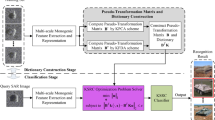Abstract
In this paper, a novel image feature extraction technique, called two-dimensional maximum clustering-based scatter difference (2DMCSD) discriminant analysis, is proposed. This method combines the ideas of two-dimensional clustering-based discriminant analysis (2DCDA) and maximum scatter difference (MSD), which can directly extract the optimal projection vectors from 2D image matrices rather than 1D image vectors based on the cluster scatter difference criterion. 2DMCSD not only avoids the linearity and singularity problems frequently occurred in the classical Fisher linear discriminant analysis (FLDA) due to the high dimensionality and small sample size problems, but also saves much time for feature extraction. Extensive experiments conducted on the moving and stationary target acquisition and recognition (MSTAR) public database demonstrate that the proposed method is more effective than the existing subspace analysis methods, such as two-dimensional principal component analysis (2DPCA) and two-dimensional linear discriminant analysis (2DLDA).
Preview
Unable to display preview. Download preview PDF.
Similar content being viewed by others
References
Belhumeur, V., Hespanha, J., Kriegman, D.: Eigenfaces vs fisherfaces: recognition using class specific linear projection. IEEE Trans. on Pattern Analysis and Machine Intelligence 19, 711–720 (1997)
Swets, D.L., Weng, J.: Using discriminant eigenfeatures for image retrieval. IEEE Trans. on Pattern Analysis and Machine Intelligence 18, 831–836 (1996)
Song, F.X., Cheng, K., Yang, J.Y.: Maximum scatter difference, large margin linear projection and support vector machines. Acta Automatica Sinica 30, 890–896 (2004) (in Chinese)
Liu, Y.J., Chen, C.K.: Maximum scatter difference discriminant analysis and face recognition. Computer Engineering and Applications 34, 208–210 (2006) (in Chinese)
Song, F.X., Zhang, D., Mei, D.Y.: A Multiple Maximum Scatter Difference Discriminant Criterion for Facial Feature Extraction. IEEE Trans. on System, Man, and Cybernetic-Part B: Cybernetics 37, 1599–1606 (2007)
Chen, X.W., Huang, T.: Facial expression recognition: a clustering-based approach. Pattern Recognition Letters 24, 1295–1302 (2003)
Zhu, M., Martinez, A.M.: Subclass Discriminant Analysis. IEEE Trans. on Pattern Analysis and Machine Intelligence 28, 1274–1286 (2006)
Ma, B., Wong, H.S.: 2D clustering based discriminant analysis for 3D head model classification. Pattern Recognition 39, 491–494 (2006)
Yang, J., Zhang, D., Frangi, A.F., Yang, J.Y.: Two-dimensional PCA: a new approach to appearance-based face representation and recognition. IEEE Trans. Pattern Analysis and Machine Intelligence 26, 131–137 (2004)
Li, M., Yuan, B.: 2D-LDA: a statistical linear discriminant analysis for image matrix. Pattern Recognition Letters 26, 527–532 (2005)
Likas, A., Vlassis, N., Verbeek, J.: The global k-means clustering algorithm. Pattern Recognition 36, 451–461 (2003)
Hu, L.P., Liu, J., Liu, H.W., Chen, B., Wu, S.J.: Automatic Target Recognition based on SAR images and Two-Stage 2DPCA features. In: 1st Asian and Pacific Conference on Synthetic Aperture Radar, pp. 801–805. Institute of Electrical and Electronics Engineers Computer Society, Piscataway (2007)
Yuan, C., Casasent, D.: A new SVM for distorted SAR object classification. In: Proc. of SPIE on Optical Pattern Recognition XVI, vol. 5816, pp. 10–22 (2005)
Gonzalez, R., Woods, R.E.: Digital Image Processing, 2nd edn. Addison-Wesley Longman Publishing Co., Inc., Boston (1992)
Musman, S., Kerr, D.: Automatic Recognition of ISAR Ship Images. IEEE Trans. on Aerospace and Electronic Systems 32, 1392–1404 (1996)
Author information
Authors and Affiliations
Editor information
Editors and Affiliations
Rights and permissions
Copyright information
© 2009 Springer-Verlag Berlin Heidelberg
About this paper
Cite this paper
Hu, L., Liu, H., Wu, S. (2009). Two-Dimensional Maximum Clustering-Based Scatter Difference Discriminant Analysis for Synthetic Aperture Radar Automatic Target Recognition. In: Yu, W., He, H., Zhang, N. (eds) Advances in Neural Networks – ISNN 2009. ISNN 2009. Lecture Notes in Computer Science, vol 5552. Springer, Berlin, Heidelberg. https://doi.org/10.1007/978-3-642-01510-6_74
Download citation
DOI: https://doi.org/10.1007/978-3-642-01510-6_74
Publisher Name: Springer, Berlin, Heidelberg
Print ISBN: 978-3-642-01509-0
Online ISBN: 978-3-642-01510-6
eBook Packages: Computer ScienceComputer Science (R0)




